
11 minute read
Bear Tracks Travel Center
Bear Tracks Travel Center serves as both an introduction to the Lake Toxaway community and a gateway to the natural wonders of the Southern Appalachians. For more details, call (828) 862-8992 or (828) 883-8968 or visit beartrackstravelcenter.com.




The lure of Lake Toxaway (North Carolina’s largest private lake), with its 14 miles of scenic shoreline, has been attracting celebrities, dignitaries and America’s first families for decades.
No less a draw to the area is the Bear Tracks Travel Center.
In 2000, Brevard natives Pam and Ron Banther purchased an existing convenience store on Rosman Highway.
Now known as the Lake Toxaway Trading Post, and operating much like an old time general store, Lake Toxaway Trading Post has for two decades supplied locals and visitors with supplies – from fuel, tobacco, snacks and groceries to lottery tickets.
Ultimately, the success of the store offered a sign that Lake Toxaway was drawing increasing travelers seeking further services and supplies. In 2003 they enlisted Pam’s brother, John, to join them in an expanded venture adjacent to the existing store. And in 2005 they opened their outdoor store, the Bear Tracks Trading Company – the two stores forming the Bear Tracks Travel Center.
Today, Bear Tracks Travel Center has become a destination for locals and visitors needing supplies and gifts.
Outside, Bear Tracks Trading Company, with its logged façade, is classic North Carolina Mountain. Inside, along with Carhartt clothing, camping supplies, t-shirts, and greeting cards, and souvenirs there are nods to the local community – jams, jellies, honeys, local pottery and arts.
Bear Tracks Trading Company offers outdoor gear and supplies for camping, hunting and fishing, including guns and ammo.
Perhaps the biggest allure at Bear Tracks Trading Company is the Adventure Center.
True to its name, it offers a wide range of explorations and excitements for outdoor enthusiasts.
The most popular of those attractions is the Gem Mining Center. With precious stones including sapphires, amethyst or even emeralds, explorers have the thrill of the search and a chance to hit the jewel jackpot. As travel has increasingly grown into a family activity, the demands for gemstone mining have increased, becoming a growing favorite with area visitors. More gemstones and rock formations are also available in the retail store.
Popular with water enthusiasts is the three-mile, two-hour tubing adventure; a chance to drift lazily down the river, while taking in the idyllic sights and sounds of nature. (Vest and tube rentals are also available.) Newcomers and avid fisherman alike know they can rely on a hefty inventory of fishing supplies and a list of services available at Bear Tracks Trading Company.
Over the years the Bear Tracks Travel Center is a place where people of all ages and from all locales meet to gear up and hang out, many returning year after year. Bear Tracks Trading Center is open seven days a week, yearround. Hours are expanded during the summer months. For more details and hours or to reserve a spot in one of the center’s popular adventures, call (828) 862-8992 or (828) 883-8968 or visit beartrackstravelcenter.com.


Where Five Streams Converge
Gorges State Park is a pristine corner of Blue Ridge splendor.
Hooker Falls
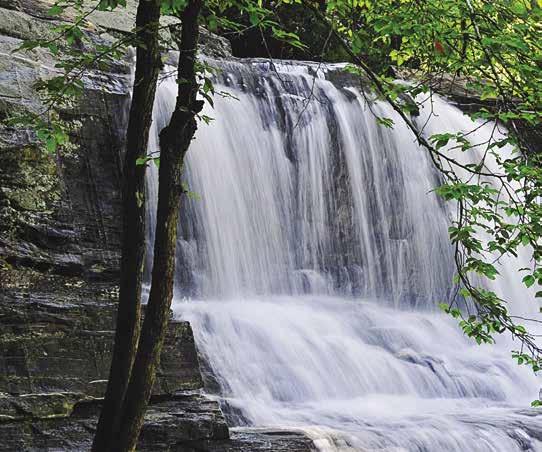


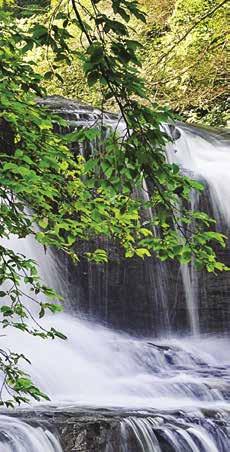
Gorges State Park, located in Sapphire along the Blue Ridge Escarpment (an area where five streams carry water to the ocean from the divide between the Tennessee Valley drainage and the Atlantic drainage), opened in 2009 in one of our state’s most breathtaking settings.
It offers an outdoor experience that can be enjoyed by everyone, from those seeking an authentic backcountry experience to a casual daytripper.
Set among primitive forests and rugged river gorges, this nearly 8,000-acre park features 26 waterfalls, the northern boundary of Lake Jocassee, 56 miles of hiking trails, including a portion of the Foothills trail, 17 miles of biking trails and 12 miles of horseback trails. It’s the home to 125 plant and animal species, several of which are considered threatened or endangered.
Magnificent plunging waterfalls are its biggest attraction, most notably Rainbow Falls and Turtleback Falls on the Horsepasture River, and accessible by the park’s-most traveled trail. This moderate three-mile round trip hike is enjoyed by thousands of visitors a year. Shorter trails with panoramic views are also within the park’s boundaries, as are longer and more strenuous trails.
The main entrance to the park is at 976 Grassy Ridge Road where a state-of-the-art wheelchair accessible Visitors Center is packed with information and exhibits explaining the area’s history and ecological uniqueness. They also offer trail guides and information on all the park has to offer, and picnic tables for all to enjoy.
The park is admission-free and there’s ample parking. In addition to the miles of hiking trails, the park has picnic shelters, primitive campsites (reservations required) and trout fishing.
It is important to note that this area is trash free so you carry out what you bring in. Recycling containers are provided throughout the area.
As a newer park, trails and campsites are continuing to be developed so visitors should always be on the lookout for new opportunities to enjoy our area’s backcountry. For more information, visit ncparks.gov/gorges-statepark/home.
by Mary Jane McCall photo by Charles Johnson
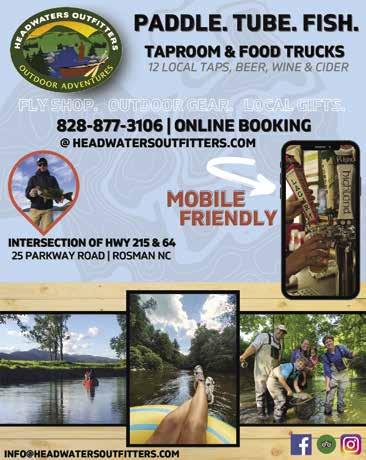
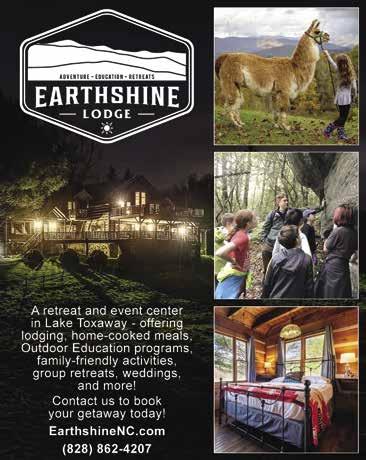
A Tribute to Toxaway
Lake Toxaway has been inviting people to slow down for over 100 years.



Lake Toxaway and the community of Toxaway that’s sprung up around it have always served as a respite from the cares of the world.
This pristine portion of mountain beauty has been offering sanctuary and respite to those in need. Back then, it was personages like Henry Ford and Thomas Edison. Nowadays, it’s celebrities like Nicole Kidman and Keith Urban, Steve Martin, and Stephen King.
When J Frances Hayes founded the Toxaway Company in 1896, he envisioned a grand resort built along the lines of the great European inns. His Toxaway Inn was marketed to millionaires and sat upon the shore of Lake Toxaway, the first large artificial lake in Western North Carolina. He even built a railway that would carry guests from Brevard up to the doors of his resort.
The inn boasted electricity and long-distance telephone service, an orchestra for evening dances, exclusive French cuisine, a bowling alley, miles of hiking trails, and guided fishing and hunting services.
Unfortunately, all of this luxury was predicated upon the beauty of Lake Toxaway, which was established by constructing an earthen dam upon the Toxaway River.
Heavy rains during the summer of 1916 were compounded by a hurricane that pushed up from the Gulf of Mexico and flooded this corner of Western North Carolina. The dam that had created the lake collapsed in spectacular manner (you can see evidence of the mountainscouring disaster in US 64 at Toxaway Falls.
That marked the end of the lake and the end of the resort lifestyle until 1960 when the Lake Toxaway Company bought the 8,900 acres of land and rebuilt the dam (this time with proper engineering to ensure safety regardless of the weather).
by Luke Osteen / photo by Susan Renfro





HISTORY
Pages 144-146
Photo by Susan Renfro

The photograph above was taken at Knoxville, Tennessee on January 1, 1865.
It shows a group of nine Union Army officers who had escaped from Confederate prisons and the three Western North Carolina citizens who had guided them to safety in East Tennessee, which was Union-held territory.
They’re all adults, except for one who was a 14 year-old-boy from Cashiers named Thompson Roberts Zachary, also called Tom or Tommy or T.R. He was the son of Alexander “Andy” Zachary, a Union sympathizer who often gave aid to escaped Union soldiers. When that boy grew up, he became one of my great-grandfathers.
When the group of nine Union officers showed up at Alexander Zachary’s Cashiers home in late December, 1864, there was deep snow and freezing temperatures outside. It was a brutal winter. They were fed and got some much needed rest in the warm house and made a plan to continue their journey to safety in Tennessee.
Union officer M. M. Bassett of Illinois promised Alexander that if Tommy was allowed to be one of the guides, he (Bassett) would, after the war was over, pay Tommy’s way through college.
The group walked west until they reached Union-held territory in Tennessee, boarded a train there and got off in Knoxville, where a photographer lined them up and took their picture. Tommy is on the top row, last one on the right.
Years later, around 1895, M. M. Bassett, who had subsequently become an Illinois state senator and a judge, got in touch with T.R. Zachary in Cashiers, then returned to Cashiers where the two men retraced their long ago trek from Cashiers to Knoxville. Bassett also mailed Zachary a copy of the photo taken on January 1, 1865, listing the names of each person in the picture.
Flash forward to the year 2021, when I got a phone call from Steve Procko, a Civil War buff, who has a home in North Georgia. His neighbor, a descendant of one of the adult guides on the Cashiers to Knoxville escape, showed Steve the January 1, 1865 picture, complete with the names of Union officers and their guides. Intrigued, Steve began doing email research on the people in the picture and quickly ran across a copy of the picture on the cover of a book titled To Die in Chicago, Confederate Prisoners at Camp Douglas, 1862-65 by George Levy. The picture was misidentified as “Morgan’s Raiders,” Confederate prisoners at Camp Douglas. The photo was noted to reside in the Chicago Historical Society, which is presently closed due to Covid-19, but Steve is working on proof that the picture needs to be re-identified.
Stay tuned – I’ll have an update for you in a few months.
A Civil War Escape
Connections forged in a desperate Civil War escape were revisited decades later by the participants.
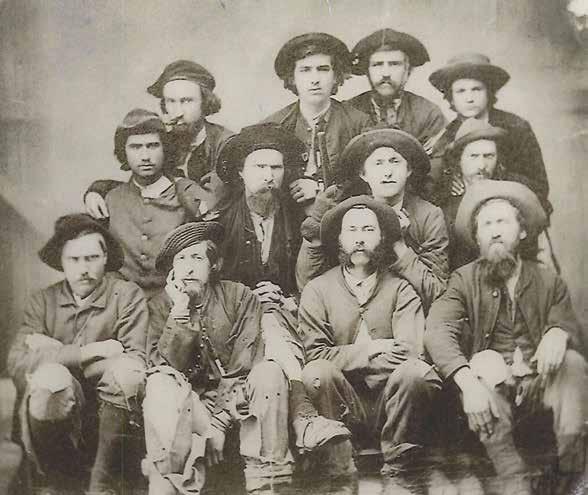
by Jane Gibson Nardy, Historian, Cashiers Historical Society
Postmaster Baxter White
Highlands Postmaster Baxter White brought a healthy dose of Mountain Fortitude to his responsibilities.
Part of the charm of 1870s Highlands was its seclusion. But living high above the problems of the down-below had its own challenges.
When Ulysses, in the film Oh, Brother, Where Art Thou, was stuck in a remote town and needed a part for his jalopy or a tin of Dapper Dan hair pomade, he was told he’d have a 2-week wait. He growled, “Well, ain’t this place a geographical oddity … two weeks from everywhere.”
But Highlanders were a tough lot and knew what they were in for. They strong-armed boulders into enough submission to expose a patch of loamy soil to plant a summer crop.
One of the most important things they didn’t have was reliable mail delivery.
I recently learned a new word: rezarfrez. It’s urban-slang for grumbling under one’s breath. Think of all the rezarfrezzing residents uttered in a three-mile wrestling match with Mother Nature down to Horse Cove (the nearest post office).
You couldn’t even surrender to gravity and roll down the mountain for all the switchbacks. Fahgeddabout rolling back up. Of course, as the crow flies it was about 100 yards here-to-there (kidding). Too bad they couldn’t teach crows to deliver mail. But have you ever heard a crow complain? They’d be rezarfrezzing rural routes all day long. Best you hitch up your mule and whistle up your dog and rezarfrez-it yourself.
In 1876 a unanimous Hallelujah reverberated throughout river gorges and granite cliffs. Postmaster Baxter White made the trip up the winding stretch of rocky road to his Highlands home/ grocery/post office all under one roof. It was there you picked up your mail. The rezarfrez-level dropped significantly that day (except maybe for Baxter) and stayed that way for the next 14 years under his purview.
To learn more about the evolution of Highlands’ postal delivery, read Ran Shaffner’s Heart of the Blue Ridge, visit highlandshistory.com, or email hhs@highlandshistory.com.









